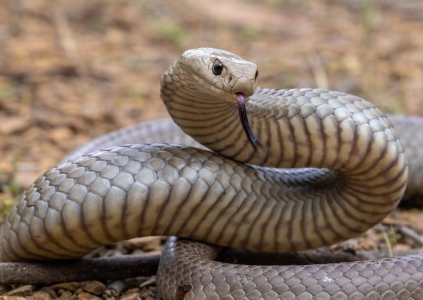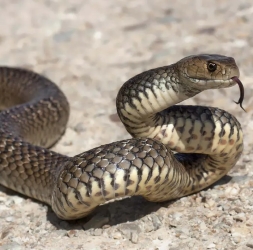  The Eastern Brown Snake is a medium sized snake, with a slender build and a small head barely distinct from the neck. Body colour may be almost any shade of brown, ranging from near black to light tan. The species is widespread throughout eastern Australia.
The Eastern Brown Snake is a medium sized snake, with a slender build and a small head barely distinct from the neck. Body colour may be almost any shade of brown, ranging from near black to light tan. The species is widespread throughout eastern Australia.Eastern Brown Snakes can be found in agricultural areas, and also in the suburbs of many large towns and cities. They shelter beneath fallen logs and large rocks, within soil cracks, and in animal burrows. They often make use of man-made items like building material for cover. Females can lay up to 25 eggs in a clutch. The eggs can take anywhere from 36 to 95 days to hatch, depending on the temperature. Eastern Brown Snakes eat many vertebrates, including frogs, reptiles and reptile eggs, birds and mammals, as well as rats and mice. Brown snakes hunt by actively seeking prey and searching out likely hiding places. They have good eyesight and once prey is detected they will give chase and subdue the prey using both venom and constriction. However, like many predators, they cannot deal with the effects of cane toad venom and rapidly die from ingesting them. The brown snake's known predators include birds of prey and feral cats. They appear to have immunity to the venom of a potential predator, the Mulga snake, as well as their own species. Many brown snakes are killed by road vehicles every year, both accidentally and on purpose, while many others are killed on sight by landowners.  Because the Brown snake thrives in areas that humans occupy, including some of the most populated parts of the country, this species is encountered more than any other type of snake. Being a nervous species like the Taipan, they often react defensively if surprised, putting on a fierce display and striking with little hesitation. However, if approached over a distance, they will usually choose to flee or else remain stationary, hoping to avoid detection.
Because the Brown snake thrives in areas that humans occupy, including some of the most populated parts of the country, this species is encountered more than any other type of snake. Being a nervous species like the Taipan, they often react defensively if surprised, putting on a fierce display and striking with little hesitation. However, if approached over a distance, they will usually choose to flee or else remain stationary, hoping to avoid detection.When confronted by an intruder, the Brown displays one of two forms of threat. In a mild threat, the snake raises its head and back part of its body slightly off and parallel to the ground, with the neck spread and slightly hooked, but the mouth closed. If issuing a strong threat, the snake raises the back part of its body well off the ground in an s-shaped coil, with its mouth slightly open, ready to strike. In this posture, the snake faces the threat more squarely. Strikes delivered from this posture are slower but more accurate. The fangs of the Eastern Brown are quite small, around 3mm, as is the average venom yield. However what the snake lacks in venom delivery it makes up for in potency. The venom contains powerful neurotoxins, procoagulants, cardiotoxins and nephrotoxins, and successful envenomation can result in progressive paralysis and uncontrollable bleeding. Occasional fatalities have occurred as a result of bleeding into the brain. As the initial bite is usually painless and difficult to detect, anyone suspected of receiving a bite from an Eastern Brown Snake should call for medical attention immediately. The Eastern Brown has the distinction of causing more deaths from snake bite than any other species of snake in Australia. Many bites have been a direct result of people trying to kill these snakes, and could obviously have been avoided. |